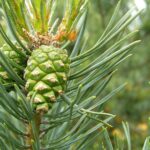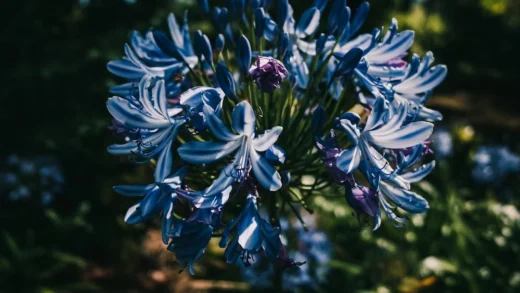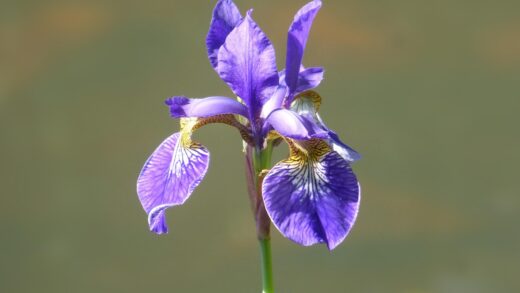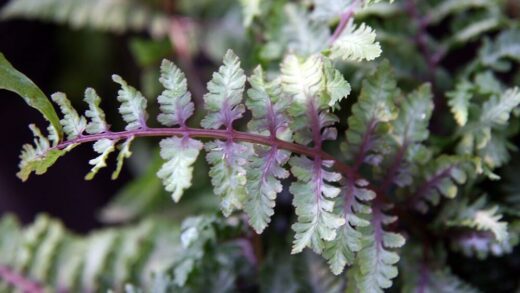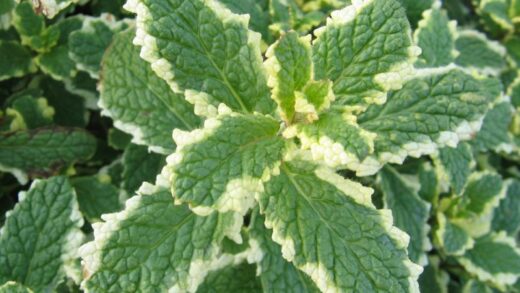In its natural woodland environment, Daphne laureola thrives in soil that is consistently replenished with nutrients from the natural decomposition of leaf litter and other organic matter. This process creates a fertile, humus-rich medium that provides a slow, steady, and balanced supply of everything the plant needs to grow. For the home gardener, the goal is to replicate this gentle and sustainable system of nourishment rather than relying on aggressive feeding schedules with synthetic fertilisers. An approach focused on building healthy, living soil will always yield better long-term results for this shrub than frequent applications of concentrated plant food.
Spurge laurel is not considered a heavy feeder and is generally quite content in moderately fertile soil. Over-fertilisation is a far greater danger than under-fertilisation, as it can lead to a host of problems. Excess nitrogen, in particular, can stimulate rapid, weak, and sappy growth that is much more susceptible to attack from pests like aphids and more vulnerable to frost damage. It can also inhibit flowering, as the plant puts all its energy into producing foliage at the expense of blossoms. A lean, balanced approach to nutrition is therefore the most prudent strategy.
The foundation of good nutrition for a spurge laurel is laid at the time of planting. Incorporating generous amounts of well-rotted organic matter, such as garden compost, leaf mould, or well-decomposed manure, into the planting hole provides an excellent starting reservoir of essential nutrients. This initial soil improvement will support the plant for a considerable time as it establishes itself. This single act of thorough soil preparation is more beneficial than any subsequent feeding regime and sets the stage for a healthy, self-sufficient plant.
Ongoing nutrition is best provided through the annual application of an organic mulch. Spreading a two to three-inch layer of compost or leaf mould around the base of the plant each spring or autumn mimics the natural process of the forest floor. As this mulch is broken down by soil organisms like worms and microbes, it slowly releases its nutrients into the soil, providing a gentle, continuous feed throughout the year. This method not only nourishes the plant but also improves soil structure, conserves moisture, and suppresses weeds, addressing multiple aspects of plant care simultaneously.
Understanding essential nutrients
For Daphne laureola to thrive, it requires a balanced spectrum of essential nutrients, just like any other plant. The most important of these are the macronutrients: nitrogen (N), phosphorus (P), and potassium (K). Nitrogen is crucial for healthy leaf and stem growth, giving the foliage its rich, green colour. Phosphorus plays a vital role in root development, flowering, and fruit production. Potassium is essential for overall plant vigour, disease resistance, and the efficient movement of water and nutrients within the plant’s tissues. A deficiency in any of these can lead to poor growth and health.
Beyond the big three, the plant also needs a range of secondary nutrients and micronutrients, albeit in much smaller quantities. Secondary nutrients include calcium, magnesium, and sulfur. Calcium is important for cell wall structure, and since spurge laurel prefers alkaline soils, calcium is usually readily available. Micronutrients, or trace elements, include iron, manganese, zinc, and boron. While only needed in tiny amounts, a lack of any one of these can cause specific problems, such as chlorosis (yellowing leaves) due to iron deficiency, which can occur in overly alkaline soils where iron becomes less available to the plant.
The best way to provide this full range of nutrients is by cultivating a healthy soil ecosystem rich in organic matter. Compost and leaf mould are not just sources of N, P, and K; they are packed with a wide array of micronutrients and also support a thriving population of beneficial soil microorganisms. These microbes are essential for breaking down organic matter and converting nutrients into forms that the plant’s roots can absorb. A chemically-fed soil may provide the primary macronutrients but often lacks the biological activity and micronutrient diversity of an organically rich soil.
Therefore, the focus of your nutrient management strategy should be on feeding the soil, not just the plant. By regularly adding organic materials, you are supporting the entire soil food web, which in turn provides your spurge laurel with the balanced, slow-release nutrition it is adapted to. This holistic approach prevents the boom-and-bust cycles associated with synthetic fertilisers and creates a more stable, resilient, and sustainable growing environment for your shrub.
The role of soil ph
The pH of the soil, which is a measure of its acidity or alkalinity, plays a critical, though often overlooked, role in the nutrition of Daphne laureola. Soil pH directly affects the availability of nutrients to the plant’s roots. Even if essential nutrients are present in the soil, if the pH is outside the optimal range for a particular plant, those nutrients can become chemically ‘locked up’ and unavailable for uptake. This is why planting spurge laurel in soil with the correct pH is just as important as the nutrient content itself.
Daphne laureola shows a distinct preference for soils that are neutral to alkaline, typically with a pH between 7.0 and 8.0. In its native habitat, it is often found growing on limestone-based soils, which are naturally alkaline. In this pH range, the availability of key nutrients like nitrogen, phosphorus, potassium, calcium, and magnesium is optimal. The plant’s root system has evolved to function most efficiently under these conditions.
If the soil is too acidic (with a pH below 6.5), several problems can arise. Firstly, the availability of the essential macronutrients can decrease. Secondly, certain elements like aluminum and manganese can become more soluble and reach levels that are toxic to the plant, hindering root growth and overall health. An acidic environment is simply not what the plant is adapted for and will lead to chronic stress and poor performance. This is why it is so important to test your soil’s pH before planting.
If you find your soil is acidic, you can amend it to make it more suitable for spurge laurel. The most common way to raise soil pH is by adding ground limestone or dolomitic lime. The amount to add will depend on your current pH and soil type, so it is best to follow the recommendations of a soil test or the product instructions. This should be done a few months before planting to give the lime time to react with the soil. Maintaining the pH with occasional light applications of lime in subsequent years may be necessary in areas with naturally acidic soil and high rainfall.
Fertilising techniques and timing
For Daphne laureola, the best fertilising technique is one that is gentle, slow, and focused on building soil health. The primary method, as mentioned, should be the annual application of a thick layer of organic mulch. In early spring, just as new growth is about to begin, apply a two to three-inch layer of high-quality garden compost or well-rotted leaf mould around the base of the shrub. Spread it over the entire root zone, which extends out to the edge of the plant’s canopy (the dripline), but avoid piling it up directly against the main stem to prevent rot.
This single annual application is typically all the feeding a spurge laurel in good soil will ever need. The nutrients from the compost will be washed down into the soil by rain and carried deeper by worm activity, providing a slow-release source of nourishment throughout the entire growing season. This method avoids the risks of over-fertilising and chemical burn associated with synthetic granular or liquid fertilisers. It is a simple, effective, and sustainable approach that perfectly suits the plant’s modest nutritional requirements.
In cases where a plant is showing clear signs of a nutrient deficiency, such as persistent yellowing of the leaves (and you have ruled out other causes like overwatering or incorrect pH), a more direct intervention may be warranted. If you do need to use a fertiliser, choose a balanced, slow-release, general-purpose granular fertiliser. Look for one with an N-P-K ratio like 5-5-5 or 10-10-10. Apply it very sparingly in early spring, following the package directions for shrubs and scattering it lightly over the root zone before watering it in well.
Liquid fertilisers are generally not recommended for Daphne laureola in the ground, as they provide a quick, concentrated hit of nutrients that can encourage weak growth and are quickly leached from the soil. They are more appropriate for container-grown plants, which have a limited volume of soil that becomes depleted of nutrients more quickly. For a potted spurge laurel, a half-strength application of a balanced liquid fertiliser once or twice during the spring and early summer growing season can be beneficial. Avoid fertilising at all from late summer onwards, as this could encourage new growth that would not have time to harden off before winter.
Recognising signs of nutrient issues
Observing your Daphne laureola is key to identifying potential nutritional problems. A healthy, well-nourished plant will have deep green, glossy leaves and exhibit steady, if slow, growth. Deviations from this norm can often indicate an issue. One of the most common signs of a problem is chlorosis, which is a yellowing of the leaves. If the yellowing appears on the older, lower leaves first, it may indicate a nitrogen deficiency. The plant is moving this mobile nutrient from older tissues to support new growth.
If the yellowing occurs primarily on the new, younger leaves, often with the veins remaining green, it is more likely to be a micronutrient deficiency, such as iron. This type of chlorosis is a classic symptom of iron being unavailable, which is common in soils that are excessively alkaline (a pH well above 8.0). Although spurge laurel prefers alkaline conditions, extremely high pH can lock up iron. Correcting this is complex and may involve using a fertiliser containing chelated iron, which is in a form that plants can absorb more easily even in high pH soils.
Other signs can be more subtle. Stunted growth, unusually small leaves, or a general lack of vigour can point to a phosphorus deficiency, which impacts root development and overall energy transfer in the plant. A potassium deficiency might manifest as weak stems or browning along the leaf edges and tips. However, it is crucial to remember that these symptoms can also be caused by other problems entirely, such as poor drainage, root damage, disease, or improper watering.
Before you reach for the fertiliser, always conduct a thorough assessment of the plant’s overall growing conditions. Check the soil moisture, review your watering practices, and if possible, test the soil pH. In most cases with Daphne laureola, problems are more likely to stem from cultural issues (too much sun, poor drainage) than from a genuine lack of nutrients in the soil. Only after ruling out these other possibilities should you consider that a nutrient deficiency might be the root cause and take gentle, corrective action.
📷: Josep Gesti, CC BY-SA 4.0, via Wikimedia Commons







